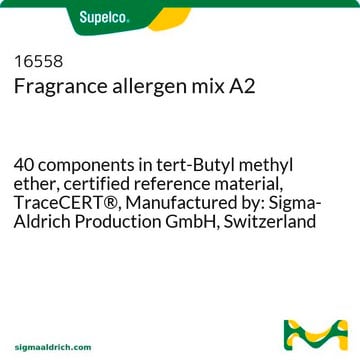64397
α-Amylcinnamaldehyde
mixture of cis and trans, analytical standard
About This Item
Recommended Products
grade
analytical standard
Quality Level
assay
≥98.0% (GC)
shelf life
limited shelf life, expiry date on the label
technique(s)
HPLC: suitable
gas chromatography (GC): suitable
refractive index
n20/D 1.557 (lit.)
n20/D 1.557
bp
287-290 °C (lit.)
density
0.97 g/mL at 25 °C (lit.)
application(s)
cleaning products
cosmetics
environmental
flavors and fragrances
food and beverages
personal care
format
neat
SMILES string
[H]C(/C(CCCCC)=C/C1=CC=CC=C1)=O
InChI
1S/C14H18O/c1-2-3-5-10-14(12-15)11-13-8-6-4-7-9-13/h4,6-9,11-12H,2-3,5,10H2,1H3/b14-11+
InChI key
HMKKIXGYKWDQSV-SDNWHVSQSA-N
Looking for similar products? Visit Product Comparison Guide
Application
Packaging
signalword
Warning
hcodes
pcodes
Hazard Classifications
Aquatic Chronic 2 - Skin Sens. 1
Storage Class
10 - Combustible liquids
wgk_germany
WGK 2
flash_point_f
294.8 °F
flash_point_c
146 °C
Choose from one of the most recent versions:
Already Own This Product?
Find documentation for the products that you have recently purchased in the Document Library.
Our team of scientists has experience in all areas of research including Life Science, Material Science, Chemical Synthesis, Chromatography, Analytical and many others.
Contact Technical Service









